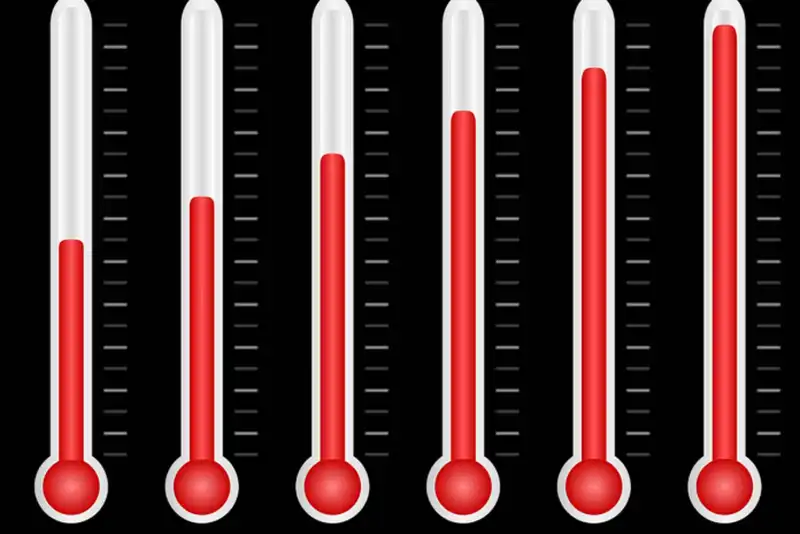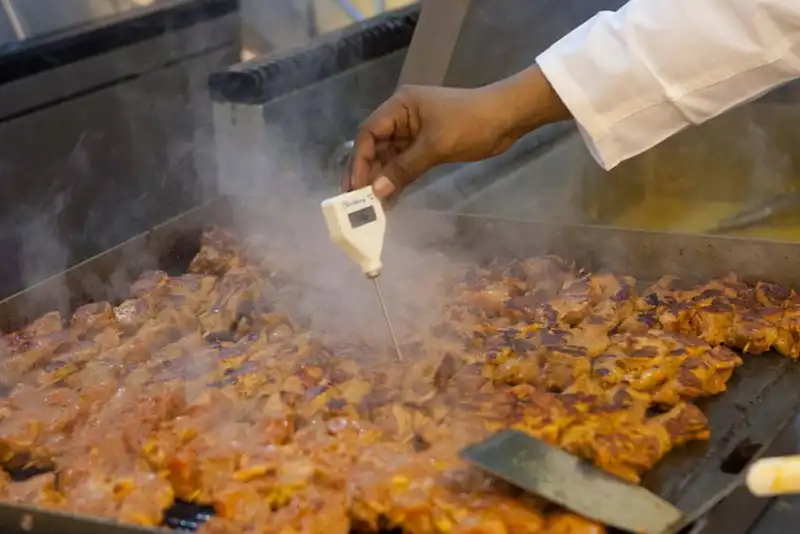What is food temperature ?
Food temperature can be tricky to understand because there are so many different types of food. It's important to know the right temperature for your dish but also in general, and how it will affect the flavor of your dish. A temperature guide is a helpful reference for understanding when it is best to cook certain dishes. Food Temperature Guide- -Frozen Food- Frozen food can be cooked from frozen most of the time but should only be used at temperatures below 0F (-18C). -Refrigerated/thawed/room temp (below 40F)- These foods should not be cooked or refrozen on their own; however, they can still be included in other dishes. -Sauce- Sauce generally starts out as a liquid and then turns into a solid by thickening due to the release of heat from water molecules. In order to avoid scorching the sauce, cook sauces at temperatures below 212F (100
A Ready Reckoner on Safe Food Temperatures for Cooking and Storing Food
Why is Food Temperature Important?
One of the important aspects of food safety for restaurants is that food is cooked at the right cooking temperatures. It is very important to ensure temperature control during food preparation to preserve the quality of food and make sure that food is safe to eat. Temperature control is essential to control the growth of harmful pathogens that can cause food borne illnesses and helps prevent related conditions like food poisoning or allergy.
Hence a restaurant has to make sure that the food is prepared and stores at optimum food temperatures recommended by the US government food safety norms. As per the guidelines, restaurants have to cook meat poultry eggs fish and vegetables at a particular minimum internal temperature for a set period of time to kill all harmful bacteria.
The guidelines state meat and eggs have to be cooked at minimum internal temperature of around 140 degree F for 15 seconds, poultry at 165 degree F for 15 seconds and vegetables have to be cooked at 135 degree F but there is no minimum time.
It is also important to store food at given food temperature as per the guidelines issued by the government to ensure that food doesn't get spoilt or bacteria starts growing.
What is the Food Temperature Danger Zone?

A food item should be safe to eat it should be cooked to the optimum internal temperature to destroy any bacteria and stored at the right holding temperature. A food item becomes unsafe for consumption when it is kept in the temperature danger zone for too long.
Danger Zone is the temperature danger range when the food has the most risk of developing harmful bacteria which can cause food borne illnesses. As per food safety guidelines, the danger zone for food is between 40 degree F and 140 degree F as the bacteria tend to grow quickly in this food temperature range. Hence hot food should be kept at above 140 F and cold foods should be kept at or below 40 F.
Any ready to eat food product can stay in the danger zone for four hours agter which it must be thrown away. Cooked food should be consumed, reheated or chilled within four hours to keep food safe. A restaurant has to check the food temperature every two hours to maintain the optimum internal temperature or take corrective actions to keep food safe. Any perishable foods kept at room temperature for over two hours and not safe and should be thrown away.
It's difficult to keep track of what temperature you should be cooking or storing your food at.
You need to know the right food temperature for each of item you cook, to avoid food contamination. This blog charts it out for you.
Ideal Food Temperatures for Cooking
As discussed earlier, different food types have different optimum internal temperatures to be considered safe for consumption. A restaurant can use a food thermometer to check if the cooked item has reached its optimal internal temperature.
Raw meat products such as steak chops and veal need to be cooked till they reach internal temperature of 145 degree F for whole meats. Ground meat products like meatballs, sausages and burger patties should be cooked till they reach Meat Temperature of 165 degree F ground meats. Poultry products have to reach an optimal internal temperature of 165 degree F to be safe for consumption but if you are cooking the whole bird then the food temperature has reach 180 degree F.
The safe internal temperature for whole eggs is around 150 degree F and vegetables have to be cooked at food temperature of 135 degree F.
Ideal Food Temperatures for Storing

Any cooked food has to be stored at food storage temperature set by the food safety guidelines to keep food safe for consumption. Once the food is cooked to optimal internal temperature it is important to either chill the food if the restaurant has plans to store the food or to keep it in a food warmer to make sure that temperature control is maintained. The food temperature to be maintained while storing the food for immediate consumption is called holding temperature.
The holding temperature for cold foods is 40 degrees F or below. Any cold foods which are not kept in the refrigerator are safe for six hours after which they must be thrown away. The food should be checked every two hours to make sure it is safe to eat.
The holding temperature for hot food is 135 degrees F or above. Hot food must be kept covered in a food warmer to ensure food safety. Keep a check every two hours with food or Meat Thermometers to ensure that the food temperature is maintained while holding the food.
How Can Safe Food Temperatures be Maintained?
To maintain food safety here are a few ways in which safe food temperatures can maintained to keep food at optimal internal temperature and safe to eat.
Cook food at the recommended internal temperature for the required period of time to make sure food is safe to eat.
If food is being held to be served in a buffet, then ensure food is kept covered in the food warmer. Stir the food regularly to ensure heat is distributed evenly to prevent growth of bacteria.
Check the food temperature with a Kitchen Thermometer every two hours to ensure that the optimal internal temperature is maintained for food safety.
Follow proper guidelines and temperature control rules for food storage while storing food like dry food, refrigerated products and dairy products.
Reheat food only once to retain the flavour and quality of food as dishes which are reheated multiple times decreases the nutritional value and increases chances of food borne illnesses.
You need to find out how long your food will last before it spoils and what temperature you should cook it at.
This blog gives you the information you need to know about cooking and storing different foods, including meat, poultry, fish, eggs and dairy products.
Best Practices for Food Safety

To make sure that food has is safe to eat, it is essential for restaurants to follow safe food practices as per Food Safety guidelines. As per Centers for Disease Control and Prevention (CDC) the four basic rules to ensure safe food are Clean, Separate, Cook, and Chill.
Here is a look at some safe food practices to make sure food adheres to Food Safety guidelines-
1. While some food items are safe to eat in their raw state like vegetables and fruits, it is better to opt for certain food items which have been processed like pasteurized milk and fresh or frozen poultry treated with ionizing radiation.
2. Make sure food items are cooked till they reach the optimal internal temperature to kill any bacteria which can cause food borne illnesses and food is safe to eat. Store food which is being served for buffet or on salad bars at the required food temperature and make sure temperature control is maintained by checking every two hours.
3. Avoid contact between food items to prevent cross contamination. If cooked food comes in contact with raw food items it can cause cross contamination which results in unsafe food. Also don't use the same kitchen equipment for different types of food like cutting raw meat and vegetables with the same knife without cleaning it first.
4. Wash hands thoroughly before you start preparing food and after preparing raw foods such as fish, meat, or poultry before you start preparing other foods. Cover any cuts or infection on hands before preparing food.
5. Keep all kitchen surfaces clean and sanitized as perishable food can be contaminated easily. Any surface used for food preparation must be washed and sanitised regularly. Cloths used to clean dishes and utensils should be changed frequently and boiled before re-use.
Food Safety FAQs
What is Rest Time?
Any meat or poultry dish should not be served immediately after it is taken off the grill or oven. If you want to enjoy a tender, juicy portion of meat, it is very important to allow the meat to rest'. The rest time of a meat can be defined as the time to allow the meat to rest' for a certain period to allow the juices to be reabsorbed to retain the flavour and prevent them from leaking when the meat is cut.
What are problems caused due to improper food storage?
Here are some other problems caused due to improper food storage -
Penalties for not following proper food safety practices
Loss of business reputation
Loss of customers
Facing legal repercussions
You want to cook your food at the right temperature, but you don't know what that temperature is.
This blog gives you the run-down of the correct food temperatures for different foods.






























































































































































